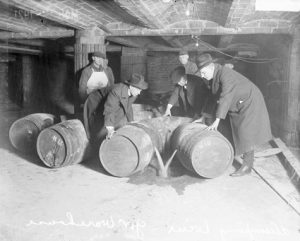
Prohibition agents destroying barrels of alcohol (Source: Wikimedia Commons)
The Prohibition Era was a period between 1920 and 1933 when the 18th Amendment to the Constitution was in effect. This amendment prohibited the manufacture, sale, and transport of alcohol in the United States.
For decades leading up to the passage of the 18th Amendment, reform groups within the temperance movement had worked to eliminate alcohol consumption, which they believed was the cause of many ills in American society. By late 1917, there was enough support in Congress to pass the amendment. However, because the language of the 18th Amendment was broad, the National Prohibition Act (also known as the Volstead Act) was passed in late 1919 to provide the specifics of alcohol regulation and enforcement. Prohibition started in 1920, after the amendment was ratified by the states.
Though Prohibition did see an overall decline in alcohol consumption in America, it had many unintended effects. For example, it led to the rise of a black-market alcohol industry of bootleggers and smugglers, which strengthened organized crime syndicates and increased gang violence. Gangsters like Al Capone became household names during this time.
Finally, during the Great Depression, the tide turned against Prohibition. In 1932, Congress passed the 21st Amendment to repeal it. The amendment was quickly ratified by the states, with the final repeal vote cast by Utah on December 5, 1933.
Learn more about Prohibition through historical newspapers from our archives. Explore newspaper articles, headlines, images, and other primary sources below.
Clippings about Prohibition
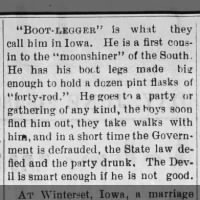 1883 article explaining the origins & meaning of the word "bootlegger" 21 Jun 1883, Thu The Miami Helmet (Piqua, Ohio) Newspapers.com
1883 article explaining the origins & meaning of the word "bootlegger" 21 Jun 1883, Thu The Miami Helmet (Piqua, Ohio) Newspapers.com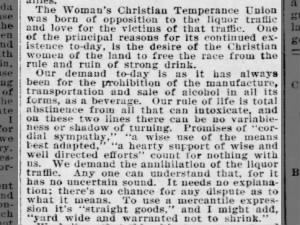 The Woman's Christian Temperance Union fights for Prohibition Sat, Jan 2, 1897 – Page 15 · Democrat and Chronicle (Rochester, New York) · Newspapers.com
The Woman's Christian Temperance Union fights for Prohibition Sat, Jan 2, 1897 – Page 15 · Democrat and Chronicle (Rochester, New York) · Newspapers.com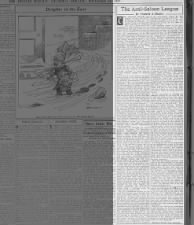 Anti-Saloon League is called "the most potent organization in politics" Thu, Nov 18, 1909 – Page 4 · Los Angeles Herald (Los Angeles, California) · Newspapers.com
Anti-Saloon League is called "the most potent organization in politics" Thu, Nov 18, 1909 – Page 4 · Los Angeles Herald (Los Angeles, California) · Newspapers.com Biography of Carrie Nation, famous for smashing up saloons with an ax Thu, Jan 19, 1911 – Page 5 · The Wichita Beacon (Wichita, Kansas) · Newspapers.com
Biography of Carrie Nation, famous for smashing up saloons with an ax Thu, Jan 19, 1911 – Page 5 · The Wichita Beacon (Wichita, Kansas) · Newspapers.com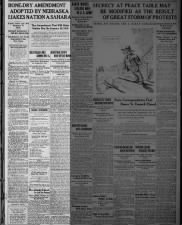 Prohibition is ratified by the states Thu, Jan 16, 1919 – 1 · The Evening Sun (Baltimore, Maryland) · Newspapers.com
Prohibition is ratified by the states Thu, Jan 16, 1919 – 1 · The Evening Sun (Baltimore, Maryland) · Newspapers.com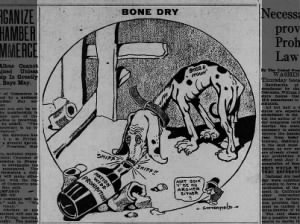 Political Cartoon: "Bone Dry" Thu, Jan 16, 1919 – Page 1 · Evansville Press (Evansville, Indiana) · Newspapers.com
Political Cartoon: "Bone Dry" Thu, Jan 16, 1919 – Page 1 · Evansville Press (Evansville, Indiana) · Newspapers.com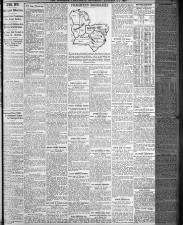 Prohibition goes into effect Sat, Jan 17, 1920 – Page 11 · The Cincinnati Enquirer (Cincinnati, Ohio) · Newspapers.com
Prohibition goes into effect Sat, Jan 17, 1920 – Page 11 · The Cincinnati Enquirer (Cincinnati, Ohio) · Newspapers.com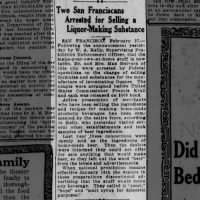 "Two San Franciscans Arrested for Selling a Liquor-Making Substance" 27 Feb 1920, Fri The Sacramento Bee (Sacramento, California) Newspapers.com
"Two San Franciscans Arrested for Selling a Liquor-Making Substance" 27 Feb 1920, Fri The Sacramento Bee (Sacramento, California) Newspapers.com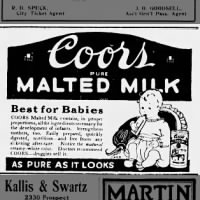 Beer maker Coors sells malted milk during Prohibition 28 Jun 1920, Mon The Kansas City Times (Kansas City, Missouri) Newspapers.com
Beer maker Coors sells malted milk during Prohibition 28 Jun 1920, Mon The Kansas City Times (Kansas City, Missouri) Newspapers.com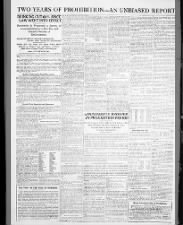 The effects of Prohibition after two years Sun, Jan 29, 1922 – Page 32 · The Ogden Standard-Examiner (Ogden, Utah) · Newspapers.com
The effects of Prohibition after two years Sun, Jan 29, 1922 – Page 32 · The Ogden Standard-Examiner (Ogden, Utah) · Newspapers.com "Deadly Toll Is Taken by Poisoned 'Moonshine'" "Many Killed, Blinded" 23 Sep 1922, Sat San Francisco Bulletin (San Francisco, California) Newspapers.com
"Deadly Toll Is Taken by Poisoned 'Moonshine'" "Many Killed, Blinded" 23 Sep 1922, Sat San Francisco Bulletin (San Francisco, California) Newspapers.com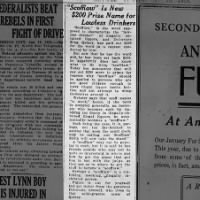 "'Scofflaw' Is New $200 Prize Name for Lawless Drinkers" 16 Jan 1924, Wed The Daily Item (Lynn, Massachusetts) Newspapers.com
"'Scofflaw' Is New $200 Prize Name for Lawless Drinkers" 16 Jan 1924, Wed The Daily Item (Lynn, Massachusetts) Newspapers.com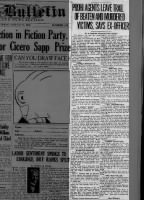 Prohibition Agents "Leave Trail of Beaten and Murdered Victims, Says Ex-Officer" 15 Mar 1924, Sat San Francisco Bulletin (San Francisco, California) Newspapers.com
Prohibition Agents "Leave Trail of Beaten and Murdered Victims, Says Ex-Officer" 15 Mar 1924, Sat San Francisco Bulletin (San Francisco, California) Newspapers.com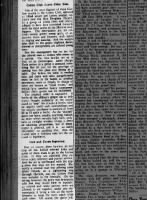 Article excerpt discussing the famous Harlem Cotton Club and its attitudes toward Black patrons 21 Feb 1925, Sat The New York Age (New York, New York) Newspapers.com
Article excerpt discussing the famous Harlem Cotton Club and its attitudes toward Black patrons 21 Feb 1925, Sat The New York Age (New York, New York) Newspapers.com "Load of Lumber Hides 3,000 Cases of Liquor" (photo) 11 Jul 1925, Sat The Times (Munster, Indiana) Newspapers.com
"Load of Lumber Hides 3,000 Cases of Liquor" (photo) 11 Jul 1925, Sat The Times (Munster, Indiana) Newspapers.com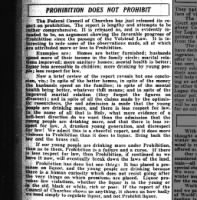 Report reveals that among the effects of Prohibition is that "young people are drinking more" 03 Oct 1925, Sat New Pittsburgh Courier (Pittsburgh, Pennsylvania) Newspapers.com
Report reveals that among the effects of Prohibition is that "young people are drinking more" 03 Oct 1925, Sat New Pittsburgh Courier (Pittsburgh, Pennsylvania) Newspapers.com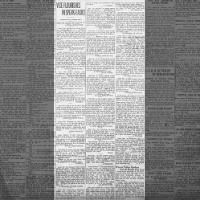 Brooklyn residents write to newspaper to reveal locations of illegal speakeasies 25 Nov 1925, Wed Times Union (Brooklyn, New York) Newspapers.com
Brooklyn residents write to newspaper to reveal locations of illegal speakeasies 25 Nov 1925, Wed Times Union (Brooklyn, New York) Newspapers.com "Radio Bedtime Tales For Children Really Code for Bootleggers" 02 Feb 1926, Tue The Selma Times-Journal (Selma, Alabama) Newspapers.com
"Radio Bedtime Tales For Children Really Code for Bootleggers" 02 Feb 1926, Tue The Selma Times-Journal (Selma, Alabama) Newspapers.com Newspaper article reviews Prohibition and its effects 6 years after start 06 Mar 1926, Sat The Vancouver Sun (Vancouver, British Columbia, Canada) Newspapers.com
Newspaper article reviews Prohibition and its effects 6 years after start 06 Mar 1926, Sat The Vancouver Sun (Vancouver, British Columbia, Canada) Newspapers.com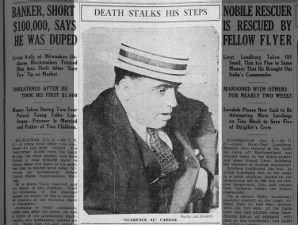 Al Capone Fri, Jul 6, 1928 – Page 1 · The St. Louis Star and Times (St. Louis, Missouri) · Newspapers.com
Al Capone Fri, Jul 6, 1928 – Page 1 · The St. Louis Star and Times (St. Louis, Missouri) · Newspapers.com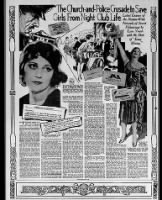 "The Church -and- Police Crusade to Save Girls from Night Club Life" 02 Jun 1929, Sun The Miami News (Miami, Florida) Newspapers.com
"The Church -and- Police Crusade to Save Girls from Night Club Life" 02 Jun 1929, Sun The Miami News (Miami, Florida) Newspapers.com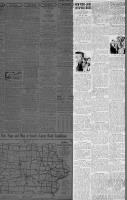 Iowa reporter describes his experience visiting New York speakeasies (excerpt) 06 Jul 1930, Sun The Des Moines Register (Des Moines, Iowa) Newspapers.com
Iowa reporter describes his experience visiting New York speakeasies (excerpt) 06 Jul 1930, Sun The Des Moines Register (Des Moines, Iowa) Newspapers.com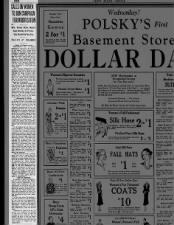 Woman gives speech in support of repealing Prohibition Tue, Oct 21, 1930 – Page 2 · The Akron Beacon Journal (Akron, Ohio) · Newspapers.com
Woman gives speech in support of repealing Prohibition Tue, Oct 21, 1930 – Page 2 · The Akron Beacon Journal (Akron, Ohio) · Newspapers.com Ad for Wine Bricks with warning that the juice "may ferment and become alcoholic" 13 Aug 1931, Thu The Sheboygan Press (Sheboygan, Wisconsin) Newspapers.com
Ad for Wine Bricks with warning that the juice "may ferment and become alcoholic" 13 Aug 1931, Thu The Sheboygan Press (Sheboygan, Wisconsin) Newspapers.com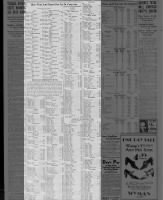 Newspaper publishes list of members of U.S. Congress & their position on Prohibition (wet or dry) 09 Nov 1932, Wed The Evening Sun (Baltimore, Maryland) Newspapers.com
Newspaper publishes list of members of U.S. Congress & their position on Prohibition (wet or dry) 09 Nov 1932, Wed The Evening Sun (Baltimore, Maryland) Newspapers.com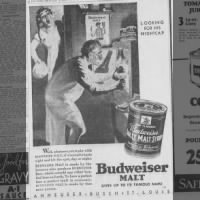 Newspaper ad for Budweiser Malt, used to brew beer 13 May 1933, Sat Tulsa World (Tulsa, Oklahoma) Newspapers.com
Newspaper ad for Budweiser Malt, used to brew beer 13 May 1933, Sat Tulsa World (Tulsa, Oklahoma) Newspapers.com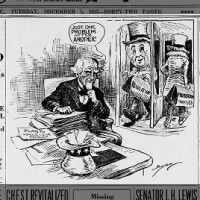 Political cartoon about the repeal of Prohibition on the federal level 05 Dec 1933, Tue Evening star (Washington, District of Columbia) Newspapers.com
Political cartoon about the repeal of Prohibition on the federal level 05 Dec 1933, Tue Evening star (Washington, District of Columbia) Newspapers.com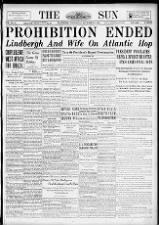 Prohibition ends with ratification of 21st Amendment Wed, Dec 6, 1933 – 1 · The Baltimore Sun (Baltimore, Maryland) · Newspapers.com
Prohibition ends with ratification of 21st Amendment Wed, Dec 6, 1933 – 1 · The Baltimore Sun (Baltimore, Maryland) · Newspapers.com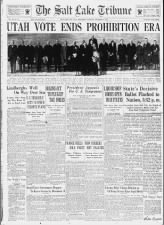 Utah newspaper coverage of the ratification of the 21st Amendment, ending Prohibition, 1933 Wed, Dec 6, 1933 – 1 · The Salt Lake Tribune (Salt Lake City, Utah) · Newspapers.com
Utah newspaper coverage of the ratification of the 21st Amendment, ending Prohibition, 1933 Wed, Dec 6, 1933 – 1 · The Salt Lake Tribune (Salt Lake City, Utah) · Newspapers.com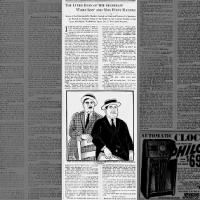 Newspaper article excerpt about famous prohibition agents Izzy Einstein and Moe Smith 02 Mar 1938, Wed The Kansas City Star (Kansas City, Missouri) Newspapers.com
Newspaper article excerpt about famous prohibition agents Izzy Einstein and Moe Smith 02 Mar 1938, Wed The Kansas City Star (Kansas City, Missouri) Newspapers.com